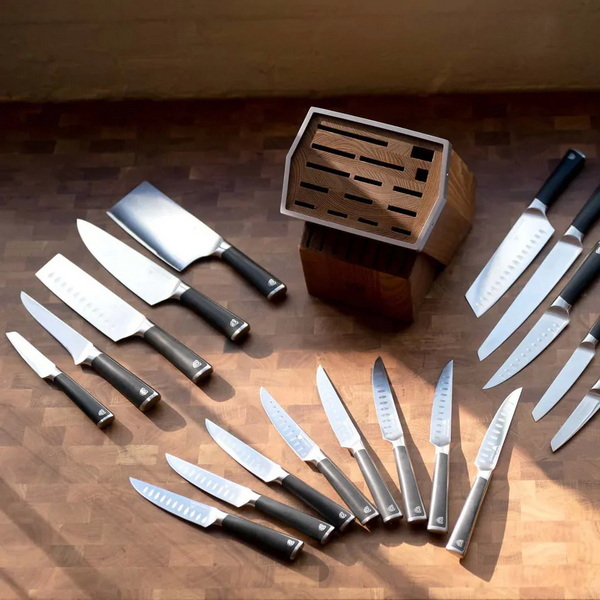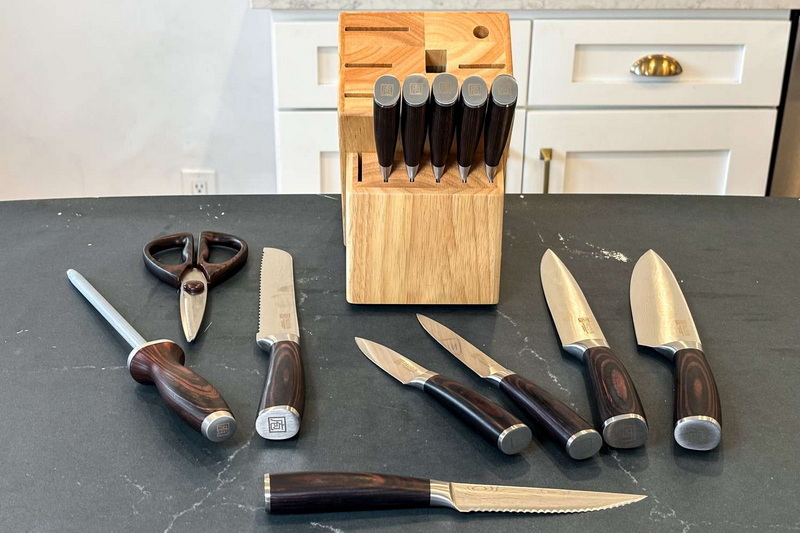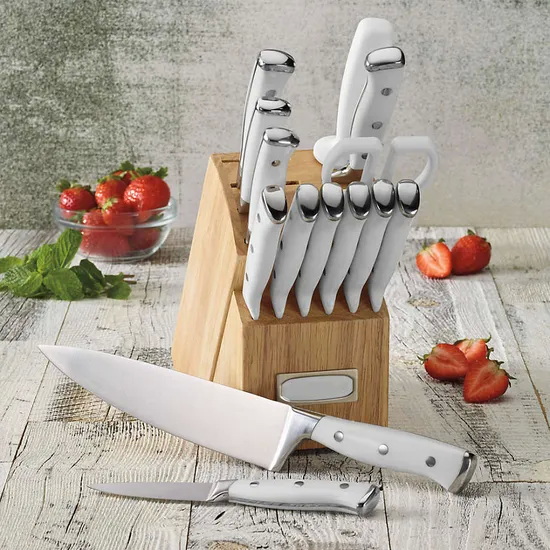

Views: 222 Author: Ella Publish Time: 2025-06-08 Origin: Site








Content Menu
● The Essential Knives Every Kitchen Needs
>> 1. Chef's Knife (8 to 10 inches)
>> 2. Paring Knife (3 to 4 inches)
>> 3. Serrated Knife (Bread Knife)
>> 4. Utility Knife (Optional but Useful)
● Other Useful Knives to Consider
>> Nakiri Knife
>> Boning Knife
● Why You Don't Need a Drawer Full of Knives
● How to Choose Quality Knives
>> Maintenance
● Building Your Knife Collection Over Time
● Proper Knife Storage and Safety Tips
● FAQ
>> 1. How many knives do most home cooks actually need?
>> 2. Can I cook well with just a chef's knife?
>> 3. What size chef's knife should I buy?
>> 4. How do I maintain my knives?
>> 5. Are specialty knives necessary for home cooking?
When setting up your kitchen, one common question arises: How many cooking knives do you really need? The answer varies depending on your cooking style, kitchen space, and budget. However, for most home cooks, a handful of well-chosen knives will cover nearly all cooking tasks efficiently. This article will guide you through the essential knives you need, explain their uses, and help you build a practical knife collection without clutter or confusion.

The chef's knife is the cornerstone of your knife collection. It is a versatile, all-purpose knife designed to handle a wide range of kitchen tasks such as chopping vegetables, slicing meat, and dicing herbs. Its broad blade and sharp edge make it ideal for most cutting jobs.
- Why you need it: It's your workhorse knife that replaces many specialized knives.
- Size: Typically 8 to 10 inches long.
- Features: Comfortable handle, balanced weight, and a sharp, durable blade.
The chef's knife offers a curved blade that allows a rocking motion for efficient chopping and mincing. It can also be used to crush garlic cloves with the flat side of the blade or scoop up chopped ingredients to transfer them to a pan or bowl. There are two main styles: Western and Japanese. Western chef's knives tend to be heavier with a more curved blade, ideal for tougher ingredients like root vegetables and large cuts of meat. Japanese chef's knives are lighter and thinner with a straighter edge, offering precision and sharpness for fruits, vegetables, and fish.
A paring knife is perfect for small, delicate tasks that require precision. Use it for peeling fruits and vegetables, trimming fat, or deveining shrimp.
- Why you need it: It offers control and accuracy for intricate work.
- Size: Usually 3 to 4 inches.
- Features: Small, nimble blade that fits comfortably in hand.
While some argue that a paring knife is not absolutely essential if you have a good chef's knife and a peeler, it does make tasks like coring tomatoes, hulling strawberries, or making small garnishes easier and more precise. For home cooks who enjoy detailed prep work, it's a valuable addition.
A serrated knife has a scalloped edge that's perfect for cutting through foods with tough exteriors and soft interiors, like bread, tomatoes, and citrus fruits.
- Why you need it: It slices cleanly without crushing soft foods.
- Size: Around 8 to 10 inches.
- Features: Saw-like teeth that grip and cut through crusts and skins.
The serrated knife is indispensable for slicing crusty bread without squashing the loaf. It's also great for delicate fruits and vegetables with thin skins. Unlike straight-edged knives, serrated knives don't require frequent sharpening and can last years with minimal maintenance.
The utility knife is a mid-sized knife that fits between the chef's and paring knives. It's great for slicing sandwiches, cutting small meats, or handling tasks too big for a paring knife but too small for a chef's knife.
- Why you might want it: Adds flexibility for medium-sized cutting jobs.
- Size: Usually 5 to 7 inches.
- Features: Slim, sharp blade for versatile use.
Though not essential, a utility knife can be a handy tool for everyday kitchen tasks that fall between the capabilities of your chef's and paring knives.
A Japanese-style all-purpose knife, the santoku is known for its versatility in slicing, dicing, and mincing. It has a slightly shorter, straighter blade than a Western chef's knife and often features a Granton edge—small scallops that help prevent food from sticking to the blade.
- Best for: Fine slicing, mincing herbs, and cutting vegetables.
- Blade length: Typically 5 to 7 inches.
The santoku is a great alternative or complement to a chef's knife, especially if you prefer a lighter knife with a straighter cutting edge.
The nakiri is a traditional Japanese vegetable knife with a rectangular blade and a very sharp, straight edge. It excels at chopping vegetables cleanly and efficiently.
- Best for: Cutting vegetables with precision.
- Blade length: Usually 6 to 8 inches.
Its flat edge makes it perfect for straight up-and-down chopping motions, ideal for preparing large quantities of vegetables.
A carving knife has a long, narrow blade designed for slicing cooked meats thinly and evenly.
- Best for: Carving roast chicken, turkey, or beef.
- Blade length: Typically 8 to 15 inches.
Its thin blade reduces drag and helps create smooth, even slices, making it a useful tool during holiday meals or special occasions.
This knife has a slim, flexible blade designed to remove bones from meat and fish.
- Best for: Deboning poultry, fish, and meat.
- Blade length: Around 5 to 7 inches.
While not essential for every home cook, a boning knife can be invaluable if you often prepare whole chickens or fish.

Many kitchen knife sets come with a dozen or more knives, including boning knives, fillet knives, cleavers, santokus, and more. While these look impressive, most home cooks only use a few knives regularly. Having too many knives can clutter your kitchen and make it harder to maintain each blade's sharpness.
Professional chefs often have specialized knives because they perform high-volume, specific tasks daily. For home cooking, investing in a few high-quality knives is more practical and cost-effective. A sharp chef's knife, a paring knife, and a serrated knife will cover over 95% of your kitchen needs.
- Stainless Steel: Durable, rust-resistant, and easy to maintain. Ideal for most home cooks.
- High-Carbon Steel: Holds a sharper edge longer but requires more care to prevent rust.
- Ceramic: Extremely sharp and lightweight but brittle and prone to chipping.
- Damascus Steel: Known for beautiful patterns and excellent performance, often pricier.
Choose knives with ergonomic handles that fit comfortably in your hand. This reduces fatigue and improves control.
Regular sharpening and proper storage will keep your knives performing well and lasting longer. Honing rods can help maintain the edge between sharpenings, while professional sharpening every few months ensures peak performance.
If you're starting from scratch or on a budget, begin with a high-quality chef's knife and a paring knife. These two knives will handle most tasks. Add a serrated knife if you frequently cut bread or tomatoes. As your cooking skills grow, you can consider adding a utility knife or specialty knives based on your needs.
To keep your knives sharp and safe, store them properly. Avoid tossing knives loosely in drawers where blades can dull or cause injury. Use a knife block, magnetic strip, or protective blade guards. Always cut on appropriate surfaces like wooden or plastic cutting boards to preserve blade edges.
When using knives, maintain focus and use proper techniques to avoid accidents. Keep knives sharp—dull knives are more dangerous because they require more force and can slip.
You don't need an extensive collection of knives to cook efficiently at home. A well-chosen set of three to four knives—a chef's knife, paring knife, serrated knife, and optionally a utility knife—will cover virtually all your cooking needs. Focus on quality over quantity to save money, space, and effort while enjoying safer and more enjoyable food preparation. As your skills and cooking style evolve, you can add specialty knives tailored to your preferences, but starting simple is the best approach for most home cooks.

Most home cooks need only three to four knives: a chef's knife, a paring knife, a serrated knife, and optionally a utility knife.
Yes, a good chef's knife can handle about 95% of kitchen tasks, but having a paring and serrated knife makes certain jobs easier and safer.
An 8 to 10-inch chef's knife is ideal for most people, balancing control and cutting surface.
Keep knives sharp by regular honing and occasional professional sharpening. Store them properly in a knife block or magnetic strip to protect edges.
Specialty knives like boning or fillet knives are usually unnecessary unless you frequently prepare specific foods like whole fish or large cuts of meat.